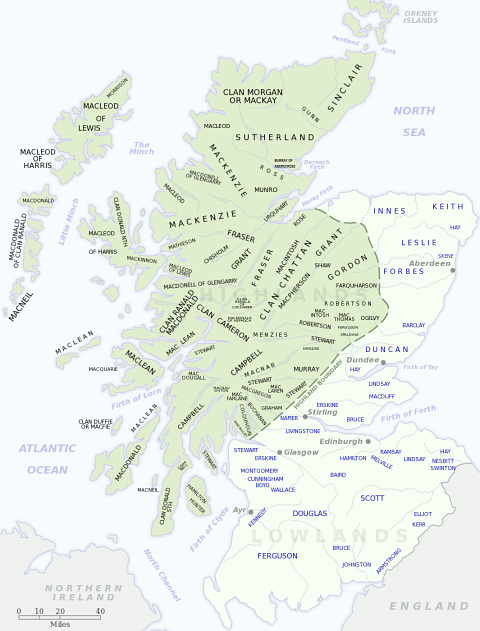
Motto: Hold fast
Historic Seat: Dunvegan Castle
District: Skye, Hebrides
Associated Surnames: Askey, Beton, Harold, Lewis, MacAskill, MacCabe, MacCaig, MacCaskill, MacClure, MacCorkindale, MacCrimmor, MacCuaig, MacHarold, MacKaskill, MacLewis, Maclure, MacRaild, Tolmie
Associated Tartans:
Early MacLeod Genealogy and History:
(Excerpt from "The Scottish Clans and Their Tartans", James Grant, 1906)
This clan is divided into two tribes - the MacLeods of Lewis, called the branch of Torquil; and the MacLeods of Harris, called the branch of Tormod. Both were powerful, and both were independent of each other, though both are descended from the son of Leod, who gave his name to the entire sept, and whose pedigree goes to a very remote ancestor called "Laigh the Strong." The chief of the Harris branch has been variously designated "MacLeod of MacLeod, MacLeod of that Ilk and of Harris."
There were other branches - Raasay in Inverness-shire, and Cadboll and Geanies in Ross-shire, besides Dunvegan in the west.
About 1344 David II granted a charter to "Malcolmo filio Turmode Maclode" for the lands of Glenelg, for which he was to render service to the King, with a ship of twenty-six oars. Another charter grants Tormod the lands of Assint. From these and other circumstances it is supposed that the Harris tribe was the senior, though Lewis was the oldest cadet. While the Lords of the Isles existed both families held their lands under them. After their forfeiture the MacLeods became independent. The Harris MacLeods had also large possession in Skye.
Alaster Crotach (or the Humpbacked) MacLeod of that Ilk (or Dunvegan), who lived in the time of James V, was the chief, who, in a quarrel with the people of Eigg, smoked scores of them to death in the Uamh Fhrainc, or cave of St. Francis. So lately as 1814, Sir Walter Scott found the floor of the cavern strewed with the bones of 200 men, women, and children of the MacDonald clan. The tomb of Alaster Crotach still remains in the Church of St. Clement in Harris. He got a gift of the lands of Ardmannach in 1498. He is called the son of William MacLeod of Dunvegan.
In the Roll of the Clans in 1587 we find Torquil of Coggach, eldest son of Roderick of the Lewis, which title and estate he claimed on his father's death, and which were disputed.
William MacLeod of Harris, Dunvegan, and Glenelg appears at the same date as chief of the Siol Tormaid; also Malcolm MacLeod of Raasay, nearest heir-male of the MacLeods of Lewis; after the descendants of the body of Roderick MacLeod of Lewis, Coggach, and Assint, chief of the Siol Torcuil.
Some time towards the close of the fourteenth century, Angus MacKay of Strathnaver married a sister of MacLeod of Lewis; and as he used her ill, the latter marched into his country, ravaged it, and fought a pitched battle in 1406 at a place Tuttumtarwigh, where he was slain with many of his clan.
On the forfeiture of MacLeod of Lewis, a life-rent grant of Assint was given to Y. MacKay of Strathnaver.
In the island of Handa, off the Sutherland coast, there lived in the reign of James VI. John M'Dhoil-vic-Huishdon, a branch of the Siol Torquil, a man of low stature, but matchless strength. "By him it was that Judge Morrison was slain. This judge had James IV's commission to maintain good order in the country; and though he was murdered by this MacLeod it was for no injury done to himself, but in revenge for his being instrumental in putting to death one of that family who acted as Laird of Lewis."
In 1605 Tormod MacLeod of Lewis, for resisting the Duke of Lennox, to whom James VI had gifted his ancient patrimony, was committed a prisoner to the Castle of Edinburgh, with Isla and several other chiefs. After ten years' captivity he was released, and went to Holland to serve under Maurice, Prince of Orange, as a soldier of fortune, and died in the ranks of the Scots Brigade.
About 1660 the superiority of Assint passed to the Earl of Seaforth after there had been fourteen successive lairds born there of that name.
"The rival family of Lewis became extinct," says Robertson, "but their heir-male is Raasay."
The MacLeods of Lewis and Harris "are both utterly extinct," wrote the Lord President in 1745. "The present Laird of MacLeod is chief of the name. He can bring out 700 men.
From some information given by "the Chevalier de Macleot" at Lisle in 1787, there would seem to have been a considerable branch of the clan settled in France since 1530, descended from David MacLeod, Gendarme of the Scottish Guard. "The present head of the family (1794) is Jean Nicolas de Macleot, Seigneur de Terreigne Pierreville, before the Revolution gentilhomme ordinair du Roi."
The stately and picturesque Castle of Dunvegan, on the west coast of Skye, is still the seat of MacLeod of that Ilk.
(End excerpt)
Next page: Clan MacMillan

Distribution of Scottish clans and families
View larger map at Wikimedia Commons

Browse the Clan MacLeod Tartan Collection with home decor, personal accessories, crafting, paper products, and more.

Browse the Clan MacLeod of Skye Tartan Collection with home decor, personal accessories, crafting, paper products, and more.

Browse the Isle of Skye District Tartan Collection with clothing, home decor, accessories, electronics cases, and more.